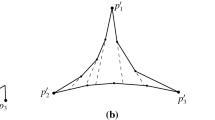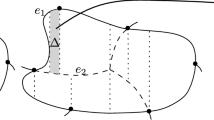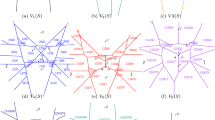Abstract
Abstract Voronoi diagrams [15,16] are based on bisecting curves enjoying simple combinatorial properties, rather than on the geometric notions of sites and circles. They serve as a unifying concept. Once the bisector system of any concrete type of Voronoi diagram is shown to fulfill the AVD properties, structural results and efficient algorithms become available without further effort. For example, the first optimal algorithms for constructing nearest Voronoi diagrams of disjoint convex objects, or of line segments under the Hausdorff metric, have been obtained this way [20].
In a concrete order-k Voronoi diagram, all points are placed into the same region that have the same k nearest neighbors among the given sites. This paper is the first to study abstract Voronoi diagrams of arbitrary order k. We prove that their complexity is upper bounded by 2k(n − k). So far, an O(k (n − k)) bound has been shown only for point sites in the Euclidean and L p plane [18,19], and, very recently, for line segments [23]. These proofs made extensive use of the geometry of the sites.
Our result on AVDs implies a 2k (n − k) upper bound for a wide range of cases for which only trivial upper complexity bounds were previously known, and a slightly sharper bound for the known cases.
Also, our proof shows that the reasons for this bound are combinatorial properties of certain permutation sequences.
This work was supported by the European Science Foundation (ESF) in the EUROCORES collaborative research project EuroGIGA/VORONOI.
Access this chapter
Tax calculation will be finalised at checkout
Purchases are for personal use only
Preview
Unable to display preview. Download preview PDF.
Similar content being viewed by others
References
Abellanas, M., Hurtado, F., Palop, B.: Transportation Networks and Voronoi Diagrams. In: Proceedings International Symposium on Voronoi Diagrams in Science and Engineering (2004)
Ahn, H.-K., Cheong, O., van Oostrum, R.: Casting a Polyhedron with Directional Uncertainty. Computational Geometry: Theory and Applications 26(2), 129–141 (2003)
Aichholzer, O., Aurenhammer, F., Palop, B.: Quickest Paths, Straight Skeletons, and the City Voronoi Diagram. Discrete and Computational Geometry 31(7), 17–35 (2004)
Alon, N., Györi, E.: The number of Small Semispaces of a Finite Set of Points in the Plane. Journal of Combinatorial Theory, Ser. A 41(1), 154–157 (1986)
Aurenhammer, F.: Voronoi Diagrams: A Survey of a Fundamental Geometric Data Structure. ACM Computing Surveys 23(3), 345–405 (1991)
Aurenhammer, F., Drysdale, R., Krasser, H.: Farthest Line Segment Voronoi Diagrams. Information Processing Letters 100(6), 220–225 (2006)
Aurenhammer, F., Klein, R.: Voronoi Diagrams. In: Sack, J.R., Urrutia, G. (eds.) Handbook on Computational Geometry, pp. 201–290. Elsevier (1999)
Aurenhammer, F., Klein, R., Lee, D.-T.: Voronoi Diagrams and Delaunay Triangulations. World Scientific Publishing Company (to appear, 2013)
Bae, S.W., Chwa, K.-Y.: Voronoi Diagrams for a Transportation Network on the Euclidean Plane. International Journal on Computational Geometry and Applications 16, 117–144 (2006)
Boissonnat, J.D., Wormser, C., Yvinec, M.: Curved Voronoi Diagrams. In: Boissonnat, J.D., Teillaud, M. (eds.) Effective Computational Geometry for Curves and Surfaces. Springer, Mathematics and Visualization (2006)
Descartes, R.: Principia Philosophiae. Ludovicus Elzevirius, Amsterdam, 1644
Fortune, S.: Voronoi Diagrams and Delaunay Triangulations. In: Goodman, J.E., O’Rourke, J. (eds.) Handbook of Discrete and Computational Geometry, ch. 20, pp. 377–388. CRC Press LLC (1997)
Goodman, J.E., Pollack, R.: On the Combinatorial Classification of Non-Degenerate Configurations in the Plane. Journal of Combinatorial Theory, Ser. A 29, 220–235 (1980)
Karavelas, M.I., Yvinec, M.: The Voronoi Diagram of Planar Convex Objects. In: Di Battista, G., Zwick, U. (eds.) ESA 2003. LNCS, vol. 2832, pp. 337–348. Springer, Heidelberg (2003)
Klein, R.: Concrete and Abstract Voronoi Diagrams. LNCS, vol. 400. Springer, Heidelberg (1989)
Klein, R., Langetepe, E., Nilforoushan, Z.: Abstract Voronoi Diagrams Revisited. Computational Geometry: Theory and Applications 42(9), 885–902 (2009)
Klein, R., Mehlhorn, K., Meiser, S.: Randomized Incremental Construction of Abstract Voronoi Diagrams. Computational Geometry: Theory and Applications 3, 157–184 (1993)
Lee, D.-T.: On k-Nearest Neighbor Voronoi Diagrams in the Plane. IEEE Trans. Computers 31(6), 478–487 (1982)
Liu, C.-H., Papadopoulou, E., Lee, D.T.: An Output-Sensitive Approach for the L 1/L ∞ k-Nearest-Neighbor Voronoi Diagram. In: Demetrescu, C., Halldórsson, M.M. (eds.) ESA 2011. LNCS, vol. 6942, pp. 70–81. Springer, Heidelberg (2011)
Mehlhorn, K., Meiser, S., Ó’Dúnlaing, C.: On the Construction of Abstract Voronoi Diagrams. Discrete and Computational Geometry 6, 211–224 (1991)
Mehlhorn, K., Meiser, S., Rasch, R.: Furthest Site Abstract Voronoi Diagrams. International Journal of Computational Geometry and Applications 11(6), 583–616 (2001)
Okabe, A., Boots, B., Sugihara, K., Chiu, S.N.: Spatial Tessellations: Concepts and Applications of Voronoi Diagrams. Wiley Series in Probability and Statistics (2000)
Papadopoulou, E., Zavershynskyi, M.: On Higher Order Voronoi Diagrams of Line Segments. In: Chao, K.-M., Hsu, T.-s., Lee, D.-T. (eds.) ISAAC 2012. LNCS, vol. 7676, pp. 177–186. Springer, Heidelberg (2012)
Author information
Authors and Affiliations
Editor information
Editors and Affiliations
Rights and permissions
Copyright information
© 2013 Springer-Verlag Berlin Heidelberg
About this paper
Cite this paper
Bohler, C., Cheilaris, P., Klein, R., Liu, CH., Papadopoulou, E., Zavershynskyi, M. (2013). On the Complexity of Higher Order Abstract Voronoi Diagrams. In: Fomin, F.V., Freivalds, R., Kwiatkowska, M., Peleg, D. (eds) Automata, Languages, and Programming. ICALP 2013. Lecture Notes in Computer Science, vol 7965. Springer, Berlin, Heidelberg. https://doi.org/10.1007/978-3-642-39206-1_18
Download citation
DOI: https://doi.org/10.1007/978-3-642-39206-1_18
Publisher Name: Springer, Berlin, Heidelberg
Print ISBN: 978-3-642-39205-4
Online ISBN: 978-3-642-39206-1
eBook Packages: Computer ScienceComputer Science (R0)




